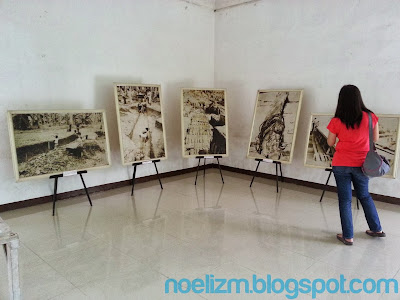Right after arrival and heavy lunch in Butuan City, Wife and I started our historical tour of the city. We went first to the city's museum but it is closed for renovation. The guard directed us to visit the Balangay Shrine Museum instead.
Our contracted trike driver charged us P 120 for a round trip and waiting package to the Balangay Museum. He do not know its exact location, so he asked the locals in the Paradise subdivision how to get there.
Above photo shows the glass-enclosed remains of the oldest watercraft in the country, complete with rudder. One of the 8 discovered balanghays (boats) accidentally discovered in 1976, experts from Tokyo Gakushuin University carbon-dated the boat to have been crafted in 320 A.D. It is now approaching 1700 years old!
Due to the damp climate in a tropical country like ours, very few fossils and artifacts survive for discovery after a long period. So I asked the museum's staff how come the wooden boats did not decomposed, even if stuck in swampland after more than a millennium.
He replied that the boats' wood material called doongon loves water, aside from being sturdy and bouyant. He added that the excavated wooden boats might decay faster when exposed to air.
Included on the museum are the wooden burial coffins produced between 14th to 15th century. Filipino archaeologists are trying to find more of them during the 70's, when they accidentally discovered the 8 wooden boats, about 16 meters away from the coffins.
There were 9 burial coffins discovered, with remains of 11 individuals. Potteries from China's ancient dynasties are also found in the coffins.
Old photos of the excavations 37 years ago are displayed in the museum.
At the back of the museum is one of the excavation sites. Most areas of Butuan during the pre-colonial era are submerged on the river delta, hence the presence of these buried ancient boats.
On our way back to downtown, I saw Mt. Mayapay, the landmark mountain plateau of the city. I hope to climb it if I get back to Butuan.
The following morning, we continued our historical tour of the city. We visited another excavation site in Barangay Libertad very close to the highway. Fyi, the modern term barangay which is the smallest unit of political district or ward in the Philippines, was coined from the word balangay.
Not too far from the Balangay Shrine Museum's excavation site, the place is also located on a neighborhood. Those private lands and houses could be harboring ancient balangays underneath them, like the one discovered last year here. Reading that news article supports the story of a pre-colonial Kingdom of Butuan, and our ancestors' trading ties with China and Vietnam.
We also visited the supposedly landing site of Magellan, when his team discovered Philippines for Europe in 1521. Its a coastal barangay in Butuan called Masaua or Masawa, which is a shortened name for Limasawa. Butuanons are claiming that the Spaniards landed in Butuan first, and not in Leyte's Limasawa island.
To support this claim, they refer to Pigafetta's historical account of a bay with boats, and a hill nearby where Magellan held the first mass in the country. They are saying that Pigafetta's description fits the Butuan's land and sea scape, while it doesn't match with topographical features of Limasawa in Leyte.
The city government erected a monument in Masawa's gray beach to further support their historical claim. Well, let's leave it to historians to resolve these opposing theories on history.
For this trip, we got the services of trike driver Nestor (0932-1937027). He's familiar with Magellan's landing site, but not on the second digging site we visited. He charged us P 160 for the whole tour. We could have gone to the hill where Magellan held the first mass, but we have to catch our flight to Manila after a quick lunch.
I hope that Butuan City's government promote their historical sites more aggressively, starting with their local constituents, and requiring them on school field trips. Street signages leading to those sites must also be installed to assist the tourists who are driving their own vehicle.


















No comments:
Post a Comment